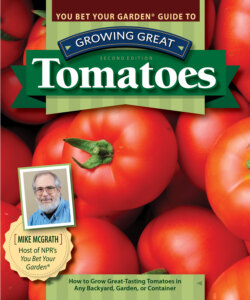Читать книгу You Bet Your Garden Guide to Growing Great Tomatoes, Second Edition - Mike McGrath - Страница 11
На сайте Литреса книга снята с продажи.
What’s Your Tomato Determination?
ОглавлениеThere are two main types of tomato plants, and the difference is important.
Determinate. Determinate plants pretty much stop growing around the time the bulk of their tomatoes form, producing almost all of their potential fruit in that one big flush. Then, they are mostly done for the season. Obviously such plants are great for large-scale farming, but they’re also good for gardeners (like moi) who cook down a lot of their crop to jar up as sauce and paste for the winter: You can pick enough tomatoes from one or two determinate plants in a couple of days to make a full pot of sauce, cook it up, and be done instead of making small batches all the time. That’s probably why most—but not all—paste tomatoes are determinate. Determinate plants also tend to be smaller and more compact, making them good choices for small-space and container gardens. And determinate varieties move in and out of your garden fast, allowing you to pull up those plants when they’re done producing and replace them with garlic, lettuce, spinach, broccoli, and/ or other fall-planted crops. (Which you should do—every space in your kitchen garden should produce at least two different runs of edibles.)
Indeterminate.Indeterminate plants grow like big honking teenagers you just bought new clothes for. Their vines don’t stop creeping toward the next county until they’re killed by frost (although they’ll slow down quite a bit when the days get shorter and the nights get cooler). Indeterminates produce flowers and fruit sequentially throughout the season, making them great choices for folks who simply want to enjoy a nice steady supply of fresh tomatoes all summer long. Just be aware that indeterminate plants tend to be large and sprawling—the opposite of compact.
Most of the old, great-tasting heirloom varieties—and big tomatoes in general—are indeterminate. The yield on some indeterminate plants is sometimes smaller than that of the more compact varieties, but sometimes their extended tomato production time evens things out over the course of a season. And big tomatoes like the treasured heirloom varieties need a larger leaf-to-fruit ratio to create their bigger, much more complex flavors, and so more of the plant’s energy has to go into making solar-collecting leaves to feed those highly anticipated fruits. As with wine grapes, the smaller the harvest, the more intense the flavor of the fruits.
The wild world of heirlooms! Crazy colors, weird shapes, and the kinds of flavor that true tomato growers crave. Don’t worry about a few “cracks” here and there, because these are the Real Deal!
These almost-a-beefsteak-but-not-quite tomatoes are clearly growing on an indeterminate plant. Pick them promptly (the one on the bottom left is ready to come inside), because prompt picking encourages the plant to keep producing.
Sometimes this “there are two types of…” thing gets out of hand. My favorite is, “There are two types of people—those who break society down into two types of people, and those who don’t.” I attribute this to Oscar Wilde but might have read it in a comic book.
Note: You may see some varieties listed as semi-determinate or described using similar weasel words. This means:
1) You can expect this variety to have some of each characteristic, maybe producing most of its tomatoes in a big flush, but on vines longer than a determinate; or (you wish), a big honkin’ variety whose vines are somewhat better behaved than the norm.
And:
2) Nobody really knows, and this way you can’t complain when what was supposed to be a cute little tomato shoves your pepper plants into the street.
